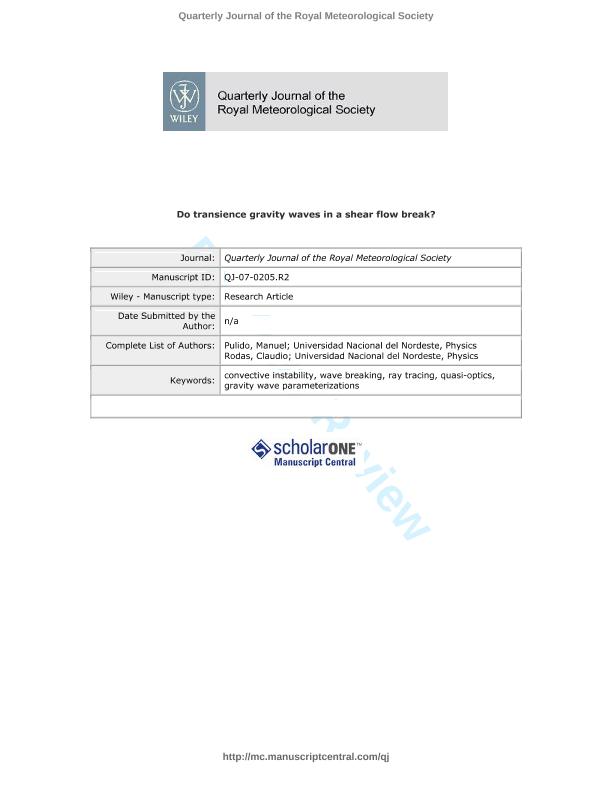Mostrar el registro sencillo del ítem
dc.contributor.author
Pulido, Manuel Arturo

dc.contributor.author
Rodas, Claudio José Francisco

dc.date.available
2017-09-21T15:01:17Z
dc.date.issued
2008-07-10
dc.identifier.citation
Pulido, Manuel Arturo; Rodas, Claudio José Francisco; Do transience gravity waves in a shear flow break?; John Wiley & Sons Ltd; Quarterly Journal Of The Royal Meteorological Society; 134; 634; 10-7-2008; 1083-1094
dc.identifier.issn
0035-9009
dc.identifier.uri
http://hdl.handle.net/11336/24787
dc.description.abstract
The propagation of transient gravity waves in a shear flow towards their critical levels is examined using a ray tracing approximation and a higher-degree (quasi-optic) approximation. Because of its transient forcing, the amplitude of transient waves decays to zero in the neighbourhood of the critical region so that it is not clear whether transient gravity waves will reach the convective instability threshold or not. The analysis shows that the horizontal perturbation decays asymptotically as the inverse of the square root of time, while the vertical wavenumber depends linearly on time, thus transient gravity waves attain convective instability for long times. The theoretical results are compared with numerical simulations. The ray path approximation is not able to reproduce the maximum amplitude, but the quasi-optic approximation gives a reasonable agreement at short and long times. There are three breaking regimes for transient gravity waves. For wave packets with a narrow frequency spectrum (quasi-steady waves) and large enough initial wave amplitude, the wave breaking is similar to the abrupt monochromatic wave overturning. On the other hand, highly transient wave packets will dissipate near the critical region for very long times with small wave amplitudes and high vertical wavenumber. The third regime is a transition between the two extremes; in this case both wave amplitude and vertical wavenumber are important to produce the convective threshold. The dependencies of the convective instability height (a quantity that may be useful for gravity wave parametrizations) on the Richardson number and the frequency spectral width are obtained.
dc.format
application/pdf
dc.language.iso
eng
dc.publisher
John Wiley & Sons Ltd

dc.rights
info:eu-repo/semantics/openAccess
dc.rights.uri
https://creativecommons.org/licenses/by-nc-sa/2.5/ar/
dc.subject
Convective Instability
dc.subject
Quasi-Optics
dc.subject
Gravity Wave Parameterizations
dc.subject
Ray Tracing
dc.subject
Wave Breaking
dc.subject.classification
Oceanografía, Hidrología, Recursos Hídricos

dc.subject.classification
Ciencias de la Tierra y relacionadas con el Medio Ambiente

dc.subject.classification
CIENCIAS NATURALES Y EXACTAS

dc.title
Do transience gravity waves in a shear flow break?
dc.type
info:eu-repo/semantics/article
dc.type
info:ar-repo/semantics/artículo
dc.type
info:eu-repo/semantics/publishedVersion
dc.date.updated
2017-08-04T15:41:08Z
dc.journal.volume
134
dc.journal.number
634
dc.journal.pagination
1083-1094
dc.journal.pais
Reino Unido

dc.journal.ciudad
Londres
dc.description.fil
Fil: Pulido, Manuel Arturo. Universidad Nacional del Nordeste. Facultad de Ciencias Exactas Naturales y Agrimensura; Argentina. Consejo Nacional de Investigaciones Científicas y Técnicas. Centro Científico Tecnológico Conicet - Nordeste. Instituto de Modelado e Innovación Tecnológica. Universidad Nacional del Nordeste. Facultad de Ciencias Exactas Naturales y Agrimensura. Instituto de Modelado e Innovación Tecnológica; Argentina
dc.description.fil
Fil: Rodas, Claudio José Francisco. Universidad Nacional del Nordeste. Facultad de Ciencias Exactas Naturales y Agrimensura; Argentina
dc.journal.title
Quarterly Journal Of The Royal Meteorological Society

dc.relation.alternativeid
info:eu-repo/semantics/altIdentifier/url/http://onlinelibrary.wiley.com/doi/10.1002/qj.272/full
dc.relation.alternativeid
info:eu-repo/semantics/altIdentifier/doi/http://dx.doi.org/10.1002/qj.272
Archivos asociados
